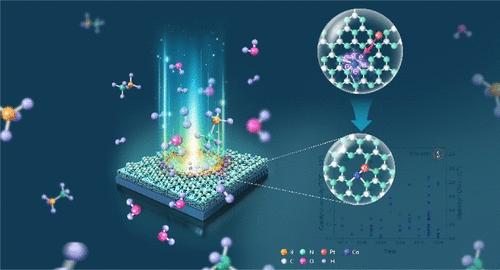Geminal Synergy in Pt–Co Dual-Atom Catalysts: From Synthesis to Photocatalytic Hydrogen Production
IF 14.4
1区 化学
Q1 CHEMISTRY, MULTIDISCIPLINARY
引用次数: 0
Abstract
Dual-atom catalysts (DACs) have garnered significant interest due to their high atom utilization and synergistic catalysis. However, developing a precise synthetic method for DACs and comprehending the underlying catalytic mechanisms remain challenging. In this study, we employ a photoinduced anchoring strategy to precisely synthesize PtCo DAC on graphitic carbon nitride (CN). A Co atom was anchored on CN through the lone-pair electrons of nitrogen. Upon light irradiation, photoelectrons gathering at the Co site can anchor Pt metal ions nearby, accurately facilitating the formation of heteronuclear DACs. The PtCo DAC demonstrates a remarkably high H2 generation rate from ammonia borane (AB) hydrolysis, with a TOF of 3130 molH2 molPt–1 min–1 at 298 K. This TOF value is approximately 3.2 times higher than that of the Pt single-atom photocatalyst. Importantly, the PtCo DAC shows good stability, achieving a turnover number as high as 307,982 molH2 molPt–1 at room temperature. The experimental and theoretical calculation results demonstrate that the synergy between Pt and Co optimizes the adsorption energy of AB and H2 molecules while reducing the energy barrier of the rate-determining step, thus accelerating H2 evolution from AB hydrolysis. Additionally, the introduced Co species stabilize the Pt active sites by enhancing the stability of the Pt–N bond, preventing leaching, aggregation, and deactivation. The excellent catalytic performance, good stability, and low cost of the catalysts in this work open new prospects for their practical application in hydrogen production.

铂钴双原子催化剂中的双原子协同作用:从合成到光催化制氢
双原子催化剂(DAC)因其高原子利用率和协同催化作用而备受关注。然而,开发双原子催化剂的精确合成方法和理解其催化机理仍具有挑战性。在本研究中,我们采用光诱导锚定策略在氮化石墨碳(CN)上精确合成了铂钴 DAC。钴原子通过氮的孤对电子锚定在氮化石墨碳上。在光照射下,聚集在 Co 位点上的光电子可以锚定附近的铂金属离子,从而精确地促进了异核 DAC 的形成。铂钴 DAC 从硼烷氨(AB)水解中产生 H2 的速率非常高,在 298 K 时的 TOF 值为 3130 molH2 molPt-1 min-1。重要的是,铂钴 DAC 表现出了良好的稳定性,在室温下的周转次数高达 307,982 molH2 molPt-1。实验和理论计算结果表明,铂和钴的协同作用优化了 AB 和 H2 分子的吸附能,同时降低了决定速率步骤的能垒,从而加速了 AB 水解过程中 H2 的演化。此外,引入的 Co 物种通过增强 Pt-N 键的稳定性来稳定铂活性位点,防止浸出、聚集和失活。本研究中的催化剂具有优异的催化性能、良好的稳定性和低廉的成本,为其在制氢领域的实际应用开辟了新的前景。
本文章由计算机程序翻译,如有差异,请以英文原文为准。
求助全文
约1分钟内获得全文
求助全文
来源期刊
CiteScore
24.40
自引率
6.00%
发文量
2398
审稿时长
1.6 months
期刊介绍:
The flagship journal of the American Chemical Society, known as the Journal of the American Chemical Society (JACS), has been a prestigious publication since its establishment in 1879. It holds a preeminent position in the field of chemistry and related interdisciplinary sciences. JACS is committed to disseminating cutting-edge research papers, covering a wide range of topics, and encompasses approximately 19,000 pages of Articles, Communications, and Perspectives annually. With a weekly publication frequency, JACS plays a vital role in advancing the field of chemistry by providing essential research.

 求助内容:
求助内容: 应助结果提醒方式:
应助结果提醒方式:


